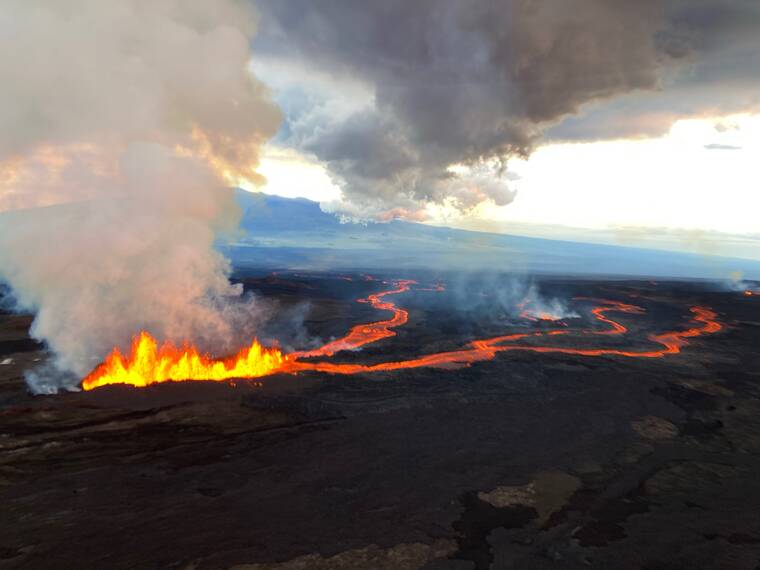Daniel K. Inouye Highway, known to many government officials as DKI and the locals as Saddle Road, is more than just a strip of pavement nearly bisecting the island. It’s a lifeline, carrying workers, goods and even trash from one side of the island to the other.
Utility lines strung alongside the road carry electricity and communication technologies from community to community. Many workers, especially in the hospitality industry, board Hele-On buses to make the long commute from Hilo and Puna, where housing is more affordable, to North Kona, Waikoloa and the Kohala coast, where the resort jobs are.
As the island’s population has grown, there are a lot more cars and trucks on the highway since the final leg was completed in 2017. Truck traffic has increased significantly with the closure of the Hilo landfill in 2020, leaving the West Hawaii landfill at Puuanahulu the island’s only rubbish dump.
All eyes have been on the lava flow from Mauna Loa as it inches slowly toward the roadway, with officials hoping against hope the flow will stop before it reaches the important transportation line.
Ken Hon, scientist in charge of the Hawaiian Volcano Observatory, said Wednesday there’s a “very high probability that this lava flow if it continues will hit the road. The question is when.”
It’s too early to tell, government officials, USGS experts and county Civil Defense said Wednesday.
But they plan to be ready if it does.
Gov. David Ige said Wednesday he issued an emergency proclamation that allows for the standing up of the Hawaii National Guard if needed, “explicitly for that purpose,” of addressing potential issues if the state highway is severed by lava flows.
In the meantime, commuters and business transports may have to rely on the coastal routes — Highway 19 to the north and Highway 11 to the south — to get across the island, Civil Defense Administrator Talmadge Magno said Wednesday.
“Those communities: Hamakua, Waimea, they’re going to see an increase in traffic,” Magno said. “It will cause congested areas to get more congested.”
The county Department of Environmental Management is still working out the logistics of dealing with the waste if the road is closed, a spokesman said late Wednesday.
Hamakua Councilwoman Heather Kimball said she sent out a notice to her constituent mailing list, telling them to be prepared for greater traffic.
“I’m hopeful it won’t come to that but people should start preparing,” she said.
But it’s not just the roadway that is of concern.
Utility companies have also been keeping careful watch.
Kristen Okinaka, spokeswoman for Hawaiian Electric, said the utility has been working closely with Hawaii County Civil Defense, Hawaiian Volcano Observatory and other agencies to monitor and evaluate the flow.
“Because of the unpredictable nature of the flow, we’re developing several plans to keep power on and will put into action the plan that best fits the situation,” she said. “ The safety of employees and community is our top priority. As the flow gets closer to our facilities, we’ll provide more specific information as to how customers could be impacted. We’re able to reroute power if lava impacts our transmission lines on Saddle Road.”
Hawaiian Telcom is also keeping tabs.
“If the lava crosses the Daniel K. Inouye highway around the 26 mile marker or below, some of our facilities may be impacted. There is resiliency built into our network so the majority of our services should not be impacted. Our teams are currently running tests to ensure that voice and data traffic will automatically re-route if necessary. We are also moving up some planned work to further increase resiliency in our network to minimize impact to our services,” said Hawaiian Telcom spokeswoman Ann Nishida Fry.
“As the lava flow is a dynamic situation, our teams will continue to monitor it around the clock and take action to minimize impact to our customers,” Fry said.
Email Nancy Cook Lauer at ncook-lauer@westhawaiitoday.com.






